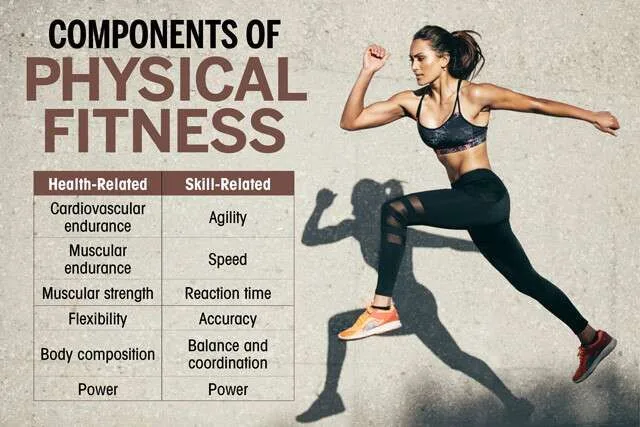Fitness
Physical fitness: The importance in daily life
The concept of physical fitness encompasses a multitude of factors vital for our holistic well-being. It entails not only the capacity to tackle daily chores with energy and resilience but also the ability to combat ailments, fatigue, and stress. From cardiovascular strength to muscular endurance, from body composition to flexibility, each component contributes significantly to our overall vitality and functionality. Embracing physical fitness isn’t solely about sprinting or weightlifting; it’s about nurturing a comprehensive approach to health that addresses various fitness dimensions. Regular physical activity and exercise stand as pivotal pillars in this endeavor, fostering not just fitness but also improving overall health outcomes. Therefore, individuals of all ages must adhere to guidelines like those outlined by the NHS for adults aged 19 to 64, ensuring they engage in suitable levels of activity to bolster their well-being.
Why is it important?
Maintaining physical fitness stands as a cornerstone of optimal health and well-being, delivering an array of advantages. Regular participation in physical exercises not only cultivates strong muscles and sturdy bones but also reinforces the functionality of the respiratory and cardiovascular systems, thereby enriching overall health. The profound benefits extend further, encompassing a diminished likelihood of major ailments such as heart disease, stroke, type 2 diabetes, and cancer, consequently reducing premature mortality rates by as much as 30%. Furthermore, a commitment to physical fitness correlates with an extended lifespan, mitigated injury risks, elevated quality of life, and augmented mental well-being and emotional equilibrium. The imperative of physical activity transcends age and body type, offering both immediate and enduring health dividends that contribute to a more vibrant and gratifying existence.
Components of physical fitness

Physical fitness comprises a spectrum of elements, comprising cardiovascular fitness, muscular strength, muscular endurance, flexibility, and body composition, each contributing to different facets of health and skill-related fitness. Cardiovascular fitness zeroes in on the efficiency of the heart, lungs, and blood in oxygen transportation. Muscular strength denotes the capacity of muscles to generate force, whereas muscular endurance pertains to their ability to endure sustained exercise. Flexibility pertains to the extent of motion at joints, while body composition reflects the balance among fat, muscle, bone, and water in the body. These components collectively shape a comprehensive understanding of physical fitness, encompassing both physiological and performance-related dimensions.
What is the method for assessing physical fitness?
Assessing physical fitness entails evaluating various elements such as body composition, aerobic capacity, flexibility, and muscular strength and endurance. Here are several common methodologies employed in measuring physical fitness:
Body Composition
Description: relative proportions of fat, muscle, bone, and other tissues in the body.
Assessment: Techniques include skinfold calipers, bioimpedance analysis (BIA), and DEXA scans.
Importance: It serves as an indicator of overall health and can influence performance across other fitness parameters.
Strength
Description: The capability of muscle groups to generate force.
Assessment: Evaluation typically involves maximal-effort trials such as squats, bench presses, or deadlifts.
Significance: fundamental for functional movements and daily tasks, particularly with advancing age.
Cardiovascular Fitness
Description: The efficiency of the circulatory and respiratory systems in delivering oxygen during physical exertion.
Assessment: Methods include the VO2 Max Test and the sub-maximal YMCA Step Test.
Importance: Enhances lung capacity, cardiac health, and overall physical fitness.
Flexibility
Description: The range of motion at joints.
Assessment: Various stretching exercises, like the sit-and-reach test and shoulder-reach, are employed.
Significance: It impacts performance in other fitness domains and aids in injury prevention.
Muscular Endurance
Description: The ability of muscles to sustain repeated contractions against resistance.
Assessment: Tests may involve maximum repetitions of exercises like push-ups, sit-ups, and pull-ups.
Significance: Improves stamina for activities necessitating repetitive motions.
Collectively, these components furnish a holistic portrayal of an individual’s physical fitness status, encompassing both health-related and skill-oriented facets. Regular evaluation of these metrics facilitates progress monitoring, highlights areas for enhancement, and supports overall well-being and fitness maintenance.
Given below is the best-selling physical fitness training guide available at Amazon:

GET MARINE FIT IN 10 WEEKS!
Product Description:
- The new edition is thorough and unexpurgated.
- Compact or format: bring it along wherever you go; access it when necessary.
- TRANSFORMATIVE EXERCISE REGIMEN is adaptable to any setting.
- Developed and endorsed by top-notch trainers from the Marine Corps to foster superior physical prowess within a set timeframe, it is perfect for individuals aiming for enhanced physical prowess, endurance, weight management, / athletic performance objectives.
- “Power lasts moments; knowledge lasts lifetimes. Opt for the hard copy!” Enhanced readability is now incorporated.
Below are some questions about daily routines concerning physical fitness, along with their corresponding answers.
How do I create a fitness plan based on my personal goals?
Crafting a fitness regimen tailored to personal objectives involves adhering to the following steps delineated in the provided sources:
- Clarify Your Objectives: Define clear and measurable fitness goals that resonate with your ambitions and requirements. Utilize the SMART goal-setting framework to ascertain that your goals are both realistic and attainable.
- Strategize Your Workouts: Select exercises that complement your goals, be they building strength, enhancing cardiovascular health, or improving flexibility. Commence gradually to sidestep overwhelming yourself or risking injury, and contemplate seeking advice from a fitness expert for direction.
- Establish a Routine: Formulate a structured workout routine encompassing designated days, times, and exercises to cultivate a consistent habit. Leverage a calendar or planner to monitor your workouts and set prompts to uphold regularity.
- Evaluate your dietary choices and devise a meal plan. Recognize the significance of nutrition in realizing fitness objectives and concentrate on maintaining a well-balanced diet. Meal planning aids in sustaining a nutritious diet and reinforces your pursuit of fitness goals.
- Periodically Review and Reassess: Commit to your devised plan for a month and gauge its efficacy. Reflect on your adherence to the regimen, the enjoyment derived from workouts, and any requisite adjustments essential for sustained advancement.
By adhering to these guidelines, individuals can tailor a customized fitness blueprint aligned with their aspirations, ensuring steadfastness, fostering overall well-being, and triumphing in attaining desired fitness results.
Explain why there is a growing concern over the physical fitness of children and adolescents.
The rising apprehension regarding the physical fitness of children and adolescents arises from several prominent factors underscored in the provided sources:
- Declining Physical Activity: Modern lifestyles, marked by increased sedentary behaviors like extended screen time and diminished active play, have precipitated a reduction in physical activity levels among youth. This lack of physical engagement contributes to a spectrum of health risks, encompassing obesity and cardiovascular ailments.
- Health Implications: Physical fitness stands as a vital component of healthy growth and development during childhood and adolescence. Consistent participation in physical activities yields manifold health benefits, including enhancements in body composition, cholesterol profiles, blood pressure, and aerobic capacity. Conversely, embracing a sedentary lifestyle constitutes a significant risk factor for obesity and associated health complications.
- Long-Term Health Ramifications: Evidence suggests that physical activity levels during formative years exert enduring effects on adult morbidity and mortality. Establishing health-conscious habits early in life proves pivotal for averting chronic diseases and upholding overall well-being throughout adulthood.
- Societal and Environmental Influences: The physical activity patterns of young individuals are subject to diverse influences, spanning familial, peer, educational, and environmental spheres. Limited exposure to opportunities that nurture confidence in physical abilities during the early developmental stages may engender diminished activity levels in later years.
In summary, the mounting apprehension regarding the physical fitness of children and adolescents stems from the adverse consequences of reduced physical activity on health, the critical role of physical fitness in overall well-being, the enduring impact on adult health, and the multifaceted influence of social and environmental factors on activity levels. Addressing these concerns necessitates the promotion of physical activity and healthy lifestyle habits from a young age to safeguard the present and future health of youth.
Must read: Muscular Endurance Mastery: Unleashing the Power Within
Describe the continuous nature of the physical fitness concept
The perpetual essence of the physical fitness notion pertains to its ever-evolving and persistent nature, stressing that physical fitness isn’t a singular accomplishment but rather an enduring voyage that offers perpetual opportunities for advancement. It encompasses the body’s capacity for adaptation, evolution, and growth across time, accentuating the significance of sustained endeavor and devotion to nurture and elevate personal fitness standards. This principle underscores the notion that physical fitness embodies a journey necessitating continual involvement and steadfast resolve to attain peak health and well-being.
Discuss why a physically active job does not guarantee better physical fitness
Achieving optimal physical fitness isn’t guaranteed solely by holding a physically demanding job, as numerous factors come into play. Although physical activity in any form generally offers benefits, the nature of certain occupational tasks might not consistently deliver the requisite intensity for an effective workout. Jobs characterised by repetitive, low-level exertion can induce fatigue and pose the risk of musculoskeletal issues, often failing to yield significant gains in cardio-respiratory fitness. Moreover, the sustained, vigorous physical demands of such roles may strain the cardiovascular system, potentially counteracting the health advantages typically associated with recreational physical activities. Studies indicate that the type, intensity, and duration of physical exertion profoundly influence its health outcomes, underscoring the significance of striking a balance between work-related obligations and leisure-time physical activities for overall well-being.
Discuss the role of behavior in physical fitness levels.
The significance of behavior in shaping physical fitness levels cannot be overstated, as it stands within individuals’ complete control, unlike factors such as heredity. Extensive research underscores the pivotal role of behavior in both kick-starting and sustaining physical activity. Strategies aimed at fostering physical activity prioritize the identification of determinants and the crafting of interventions geared toward motivating individuals to partake in consistent exercise. Elements influencing behavioral patterns regarding physical activity span personal agency, social reinforcement, environmental contexts, and communal settings. Studies emphasize the efficacy of tailored interventions that take into account individual requirements, fitness levels, autonomy, and social support networks to foster enduring engagement in physical activity among adults.



